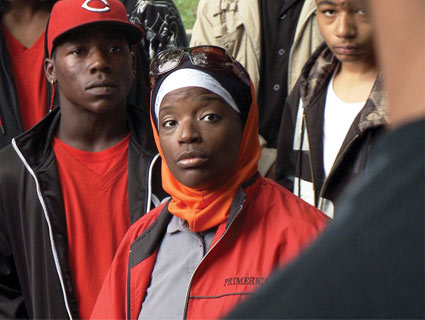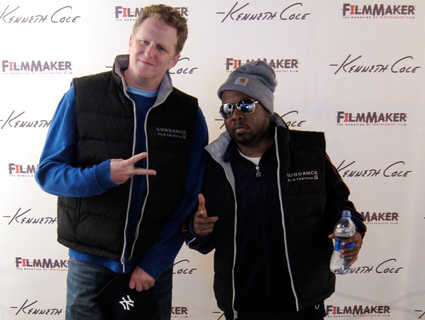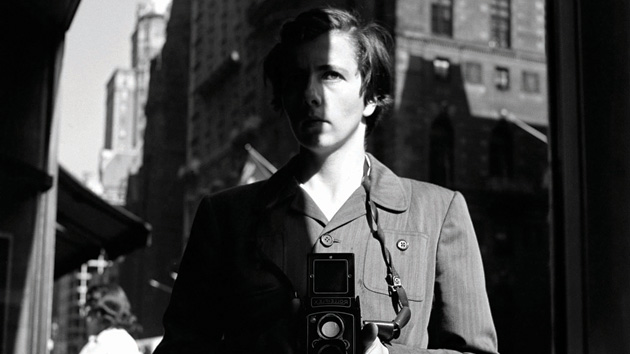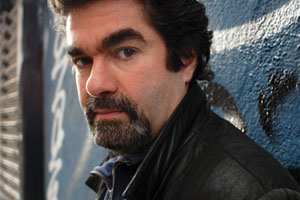
Photo: Kartemquin Films
What if inner-city violence spread like a disease—literally? Could you then tackle outbreaks of violence the way an epidemiologist might—by intervening at the point of transmission? In their new film, The Interrupters—which hit theaters in July (and airs on Frontline on Feb. 14)—Hoop Dreams director Steve James and author Alex Kotlowitz (There Are No Children Here) take us to the streets of Chicago, where an upstart organization called CeaseFire is testing that very strategy. Their intense and inspiring verité-style doc follows Cobe, Eddie, and Ameena—former badass felons turned professional “violence interrupters.” Their job is to break the cycle of retaliation by putting themselves in the middle of high-octane street feuds and convincing, say, a young gangbanger not to come back on the guy who shot his homie. As the filmmakers prepared for their big rollout, we got on the phone to talk about the roots of violence, ruffling a gang leader’s feathers, and how their subjects killed at Sundance.
Mother Jones: Alex, you first wrote about CeaseFire in 2008 for the New York Times Magazine. What attracted you to this story?
Alex Kotlowitz: Steve and I have had to deal with the violence on a very personal level. Of the kids that I met working on There Are No Children Here—one has since been killed, another four are serving time for murder, and two of the individuals in Hoop Dreams have since been murdered. It’s been somewhat perplexing. Other things change, but the one constant is the violence, and I’ve just been paralyzed by it. What really intrigued me about what CeaseFire was doing was that it offered a different way to think about it: the idea that violence mimics the transmission of infectious disease. And what particularly excited me was it took the morality out of the equation. It wasn’t a question of good and bad people; it was really about behavior. And then I met the interrupters, and you spend time with any of those men and women and you come away in awe. From the get go, they inspired me and incredibly intrigued me.
Steve James: When Alex’s piece came out, we talked on the phone and said, well, if we could get the access, this would be a terrific film to try to make. Murders are down since the ’90s in Chicago, and I think in most major cities, but Alex and I both felt that it had kind of settled into a place where the violence was accepted. I think we both hoped this film was a way of putting the issue more front and center. The thing that fascinated me most was just this notion of the interrupters as living, breathing examples of people who have profoundly changed their lives.
MJ: Now the print piece was, in considerable part, a profile of public-health researcher Gary Slutkin, CeaseFire’s founder. But Slutkin played a minor role in the film. How come?
AK: We didn’t want to make a film about CeaseFire, per se. We wanted to make a film about the violence. And in the end, Eddie, Cobe, and Ameena are kind of our prism onto that.
MJ: Slutkin’s big revelation is that you can fight violence where it spreads—by convincing people not to retaliate. Do you think that’s the best approach out there right now?
AK: I don’t know that it’s the best. But it’s one that on some level makes perfect sense. I mean, one of the things you see in the film is there’s all these forces weighing down on people: lack of work, troubled families, drug addiction, people coming back from prison not able to get jobs, and so the other part of the public-health model, of course, is to look at, you know, conditions. But I do think it offers this way to look at the violence that we haven’t really utilized before.
SJ: It’s also redemptive work for these folks; I think that was what was incredible about the concept. I think what was so moving and powerful as an experience making the film was to be able to bear witness to that and get to know them. Because you meet a guy like Eddie now—if you didn’t know that he spent 14 years in prison for murder, you would never in a million years think—
AK: Right. Or the flip side is, if you had met him back then, you would never think he’s capable of what he’s doing now. I mean, that’s in some way the even more important lesson. You meet these young men who are just filled with this anger, and to think that 20 years from now, they may very well be perfectly capable of doing what Eddie or Cobe or Ameena is doing.
MJ: Which is great, but the bigger question is whether a group like CeaseFire can actually change the culture that encourages street justice.
AK: I think the jury’s still out on that. I think it’s what they’re attempting to do. What they talk about in public health terms is to change the norm—and get people to settle grievances through other means.
MJ: And have it be okay.
AK: Right, to feel a sense of self-worth to be able to walk away from a dispute rather than walk further into it.
SJ: That’s where the infectious thing is most appealing. If certain people act out, it can affect a larger group. And if violence can infect, then good behavior can also infect—in a good way.
MJ: Steve, how did making this film compare with making Hoop Dreams?
SJ: I’ve joked that this film was sort of like Hoop Dreams on steroids. Hoop Dreams took seven years to make. We filmed for nearly five years, and edited for over two years, really. And some of that was we just weren’t very good at what we were doing. [Laughs.] And we had trouble raising money. It was also a more ambitious film in terms of scope and time. But, you know, in the span of 12 to 14 months, we shot more footage on this film than we did on the entire time on Hoop Dreams. And the whole film was really pretty much done in the span of about two years, so from a production level, I’ve never had a project that’s this ambitious happen so quickly, and be, I’m almost embarrassed to say, such a pleasurable experience, given the subject matter. We had such a great time making this film. We had a great crew. And we were hanging out with terrific people who were not only inspiring but were just also fun to hang out with. And you know, it didn’t mean that there weren’t some very dark days in terms of what we were filming and the tragedies and the sort of the sad things that we filmed that affected us all. But it really was this incredibly, sort of inspired experience.
MJ: What were your biggest challenges in bringing this from print to the screen?
AK: I think the biggest challenge was whether we could get the kind of access we needed. You know, for print, I can go back and re-create moments. The power of good film is being there in the moment. And so the question was whether we could first of all get the trust of the interrupters.
MJ: But they’d read your story.
AK: Yeah, but coming in with the camera is a bit different, perhaps a bit more intimidating. And it’s one thing to be out on the street with just a pen and paper; it’s another thing to be out there with the three of us with a camera.
MJ: Did you encounter any hostility?
SJ: Just on a couple of occasions, but given that we were with Eddie, Cobe, and Ameena, we felt pretty safe. We had an implicit understanding that, if things got uncomfortable, if things got dangerous, if they felt compromised in any way, that we would walk away. And there were instances when we did that.
AK: And then there was the situation with Eddie, in his neighborhood, Little Village. Some of the scenes early in the film where he first appears take place in Little Village, and there’s a scene there that’s not in the movie that triggered a decision by a higher-up in the gang that controls that neighborhood to tell Eddie they didn’t want to see us over there any more. Eddie pleaded the case for us. He told us he pleaded it for a couple hours, and the guy just wasn’t having it. Of course we said, “Can we go talk to him?” And Eddie said, “Uh, no.” [Laughs.] So that was that.
MJ: I was going to ask about the Heisenberg effect: whether bringing a camera into these tense situations affects the outcome.
AK: The interrupters themselves rather quickly got comfortable with us filming them, and they had such a presence, such respect, such admiration in their own neighborhoods, that they kind of set the tone. Cobe would just tell people, “Hey man, this is my film crew.”
SJ: It is the sort of classic question in documentary film, especially in these kinds of films. On some level, it’s impossible to know. There are certain situations that you find yourself in where it’s clear that the camera is having an effect. Initially, Cobe was so busy trying to please us that he was interacting as if he was interviewing them for us. We had to say, “Forget about us. If there’s something we want to know that we’re not getting from you just dealing with people the way you deal with them, then we’ll ask.” It took him a little while to get to that place, but once he did, he was great at it. So on one level it’s like, how can the camera be there and not have some sort of effect? On another level, I am continuously struck by how little impact the camera has if you don’t make a big deal of what you’re doing, if you show up with people who trust you, and people sense that.
MJ: Your characters are great. Who was your favorite?
AK: If we have a favorite child, we’re certainly not going to say it.
MJ: That’s what Terry Gilliam told me when I asked which of his films was his favorite.
SJ: [Laughs.] Well, that’s a little different.
MJ: Not to him. By the way, I thought Ameena was fantastic.
AK: Yeah, she’s a force of nature.
MJ: What kind of response did you get at Sundance?
AK: Terrific.
SJ: Sundance, bless their soul, took the film when we sent them a rough cut that was three and a half hours long—and it was very late in the process.
AK: It was actually about three and a half hours long and three months late!
SJ: As a consequence, we didn’t know what the length of the film was going to be. And so they had to put it at the end of the night for every screening. I don’t know if you’ve ever been to Sundance, but nobody wants to screen at 9:00 or 9:45 every night; plus they’ll look in the catalog and see that it’s a long film. And the printed catalog had the running time as 3:10—it was actually 2:40 at that point. [It’s now 2:05.] But I think it’s amazing the way the film overcame that. The word got around that it was worth seeing. Our interrupters were there, and they are incredible ambassadors.
MJ: I can totally imagine them going around and getting people to show up.
SJ: Oh, they were just stars! They were walking up and down Main Street talking to people and getting stopped.
AK: Ameena took over the local Public Access Channel, which is very popular there in Park City. She went in and just took over, essentially. They loved her so much they rebroadcast the piece she was in. It was just incredible.
SJ: I’ve been blessed to have this experience with Hoop Dreams before, but it was like one of those blessed Sundance experiences that filmmakers dream of.
MJ: So the film goes light on wonky details. But I’m curious about how CeaseFire is weathering state budget cuts?
AK: Right, because so much of it relies on the state. The funding has been up and down. Even during the course of filming, we saw the number of interrupters fluctuate anywhere between 20 to 50, depending. They are doing okay, you know. They’ve been replicated, or parts of it have been replicated, in about a dozen other cities. They are actually doing some work internationally. Again, I think the thing that’s important to remember is that it’s a young organization by most standards, and one that’s still finding its feet. The idea of the interrupters—there’s something so self-evident and commonsensical about it. You think, why haven’t people done this before?
Watch the trailer below:

















